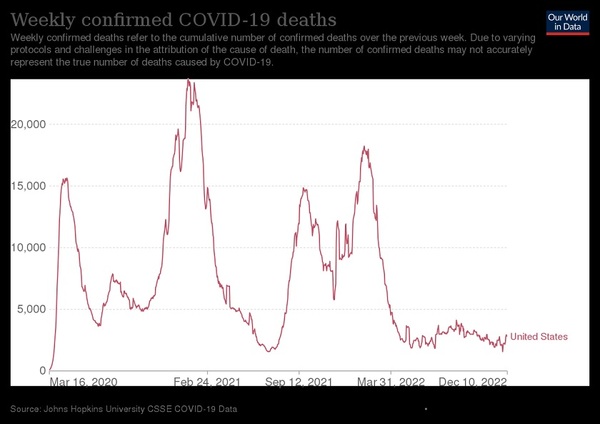
–>
December 23, 2022
It is been two years and nine months since the start of the COVID pandemic. In my region of Pennsylvania, the newest milder omicron variants are certainly about, but in greatly reduced numbers compared to last year. There is relatively little morbidity. Nonetheless, we are still forced to mask at the hospital, and once a week, symptomatic or not, because I’m unvaccinated, I am expected to be tested for the virus. Unfortunately, I see no end to this.
‘); googletag.cmd.push(function () { googletag.display(‘div-gpt-ad-1609268089992-0’); }); }
Regarding the pandemic, I feel like one does after a dangerous storm passes through your town. You spent time in preparation, boarding the windows and staying indoors. The winds and lashing rain have passed, leaving downed trees and limbs, flooded areas, and damaged homes. There is a sense of relief mixed with a feeling of sadness over what has been lost.
In a metaphorical way, this is where we are in the aftermath of COVID. The panic and hype concerning the virus have slowly waned as people come out of their homes to survey the aftermath. Business have closed, jobs have been lost. There has been significant psychological damage, with some people experiencing residual anxiety about not just COVID, but now influenza and RSV, which have recently become prevalent. The prospect of masking during the winter respiratory virus season has been floated by health officials. and I’m once again seeing more faces hidden behind cloth.
Another measure of “COVID Concern” is the number of boosters obtained by those most obsessed. I’ve encountered people that have undergone six separate injections and will be happy to have more. They are generally not receptive to alternative information.
‘); googletag.cmd.push(function () { googletag.display(‘div-gpt-ad-1609270365559-0’); }); }
A new “bivalent vaccine is being offered to the public. This vaccine was hurriedly approved, essentially without any testing. It injects you with two types of mRNA. Half of the vaccine codes for spike proteins for the long-since extinct alpha variant. One suspects this mRNA was included mainly to facilitate the inappropriately rapid approval of the new inoculation. It means that half of the mRNA load in the most recent booster codes for a toxic spike protein that no longer infects anyone.
Unfortunately, the other half of the vaccine codes for spike from an omicron variants that are also no longer prevalent (the BA.1-5 variants). The current XBB and BQ1 variants are said to evade even the bivalent vaccine immunity. There is more and more data to suggest that the majority of hospitalizations now occur in vaccinated versus unvaccinated people.
Despite this, HHS has bizarrely suggested that we get boosted every three months. Can we finally admit that the vaccine has failed? It certainly appears that those who have been preaching the futility of a vaccine strategy for a rapidly mutating coronavirus have been right all along.
 In the meantime, VAERs data compiled by the CDC as of this week there have been 72,699 hospitalizations and 15,732 deaths related to the COVID-19 vaccines since January 2020. By comparison, there have been 40,005 hospitalizations and 5,468 deaths reported in that same system for all other 26 monitored vaccines since VAERS began in 1990.
In the meantime, VAERs data compiled by the CDC as of this week there have been 72,699 hospitalizations and 15,732 deaths related to the COVID-19 vaccines since January 2020. By comparison, there have been 40,005 hospitalizations and 5,468 deaths reported in that same system for all other 26 monitored vaccines since VAERS began in 1990.
Meanwhile, insurance actuaries and the funeral industry have recorded significant increases in the number of working-class deaths since early 2021. We have begun discussing an entity called Sudden Adult Death syndrome (SADS) where young people without a history of cardiac disease are dying of cardiac arrhythmias. Every day, it seems, a young athlete or otherwise fit person succumbs. Since spike proteins created by the vaccines are known to create endothelial damage, and myocarditis, perhaps we should stop vaccinating, and start investigating the possible connection
There have been two oral medications developed for the treatment of COVID-19. Pfizer developed the drug Paxlovid, which certainly looked promising, but has suffered from its many drug interactions, reports of poor patient tolerance and recurrent infection after the drug is stopped. Merck’s Molnupivinir is more modestly protective for severe disease and death but comes with some unusual precautions. At least from this physician’s viewpoint, it has sort of fallen off the radar as a treatment. This of course has happened even though the U.S. government purchased $2.2 billion worth of this medication.
‘); googletag.cmd.push(function () { googletag.display(‘div-gpt-ad-1609268078422-0’); }); } if (publir_show_ads) { document.write(“
So what about the virus? From the CDC data appears that the current number of infections and deaths has been low and so far rather flat, particularly when compared to last year at this time. This probably reflects a variety of effects, including the tendency for the most recent variants to induce mild upper respiratory symptoms. There is also the increasing immunity of the populace, brought on by both vaccines, but also by the large number of omicron infections last winter. By some estimates, roughly 95% of people now are likely immunologically protected by vaccine or previous infection.
It’s important to remember, though, that much like the other endemic cold viruses, this coronavirus will continue to mutate, and we will continue to be somewhat susceptible. As viruses do, it should mutate to less virulent forms, and our pre-existing immunity should protect most of us from serious symptoms. It is important to remember, however, that even the previous endemic cold viruses can cause hospitalization and death in susceptible patients.
The result of all this is that the public is slowly awakening to the reality of this illness, and the futility and even risk of vaccination. The percentage of people who have opted for the new bivalent vaccine has dropped considerably from previous booster efforts. The patients I see in my clinic, are fed up with the mask requirements and are relieved when I request that they be removed for an examination.
COVID-19 will likely be with us for the foreseeable future. It is, however, no longer a pandemic. And it is not the same virus as when it appeared in the winter 2020.
The storm is over. It is time to pull the last of the plywood down, repair the damage and move on.
It’s time to go back to our lives.
Image: Our World in Data
<!– if(page_width_onload <= 479) { document.write("
“); googletag.cmd.push(function() { googletag.display(‘div-gpt-ad-1345489840937-4’); }); } –> If you experience technical problems, please write to [email protected]
FOLLOW US ON
<!–
–>
<!– _qoptions={ qacct:”p-9bKF-NgTuSFM6″ }; ![]() –> <!—-> <!– var addthis_share = { email_template: “new_template” } –>
–> <!—-> <!– var addthis_share = { email_template: “new_template” } –>





